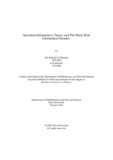| dc.contributor.advisor | Ali, Tibra | |
| dc.contributor.author | Rahman, Md Reshad Ur | |
| dc.contributor.author | Munshi, Josh | |
| dc.date.accessioned | 2021-10-19T05:53:30Z | |
| dc.date.available | 2021-10-19T05:53:30Z | |
| dc.date.copyright | 2020 | |
| dc.date.issued | 2020-10 | |
| dc.identifier.other | ID 18311003 | |
| dc.identifier.other | ID 17111003 | |
| dc.identifier.uri | http://hdl.handle.net/10361/15431 | |
| dc.description | This thesis is submitted in a partial fulfillment of the requirements for the degree of Bachelor of Science in Physics. | en_US |
| dc.description | Cataloged from PDF version of thesis. | |
| dc.description | Includes bibliographical references (pages 78-79). | |
| dc.description.abstract | This thesis discusses the information-theoretic concepts of Black Holes. Its primary
focus is describing black hole dynamics with unitary operators within the
perspective of quantum information theory and AdS/CFT arguments on why
black hole evaporation is likely to be unitary. This thesis also provides mathematical
backgrounds of classical black holes and quantum field theory in curved
space. Then we introduced entanglement entropy and compared the shell of photons
in a pure state to free harmonic oscillators. Afterward, we introduce an interaction
term in the hamiltonian for t > 0, which we call a sudden quench. Finally,
we have calculated the time evolved entanglement entropy for N-quenched oscillators
and graphically demonstrated the entanglement entropy for various N.
We want to model the time dependent entanglement entropy S1 between the internal
and emitted radiation of a black hole. As for a future project, we want
to regularize a quantum field to the Hamiltonian of N-quenched oscillators and
compute the entanglement entropy S2 that results from tracing degrees of freedom
inside an imaginary sphere. Hence, as S1 increases with time as the photons’
shell begins to collapse, we have a comparable situation, using the ideas
about holography, with the time evolution of the S2. | en_US |
| dc.description.statementofresponsibility | Md Reshad Ur Rahman | |
| dc.description.statementofresponsibility | Josh Munshi | |
| dc.format.extent | 83 pages | |
| dc.language.iso | en | en_US |
| dc.publisher | Brac University | en_US |
| dc.rights | BRAC University thesis reports are protected by copyright. They may be viewed from this source for any purpose, but reproduction or distribution in any format is prohibited without written permission. | |
| dc.subject | AdS/CFT | en_US |
| dc.subject | Classical Black Holes | en_US |
| dc.subject | Curved spacetime | en_US |
| dc.subject | Entanglement entropy | en_US |
| dc.subject | Quantum field theory | en_US |
| dc.subject | Quantum information theory | en_US |
| dc.subject | Holography | en_US |
| dc.subject | Quench | en_US |
| dc.subject.lcsh | Quantum communication | |
| dc.subject.lcsh | Quantum computers | |
| dc.subject.lcsh | Information theory--Data processing | |
| dc.subject.lcsh | Quantum theory | |
| dc.title | Quantum information theory and the black hole information paradox | en_US |
| dc.type | Thesis | en_US |
| dc.contributor.department | Department of Mathematics and Natural Sciences, BRAC University | |
| dc.description.degree | B. Science in Physics | |

